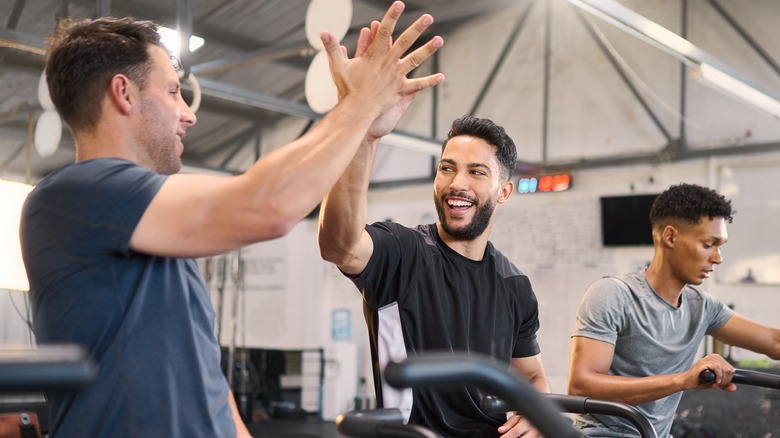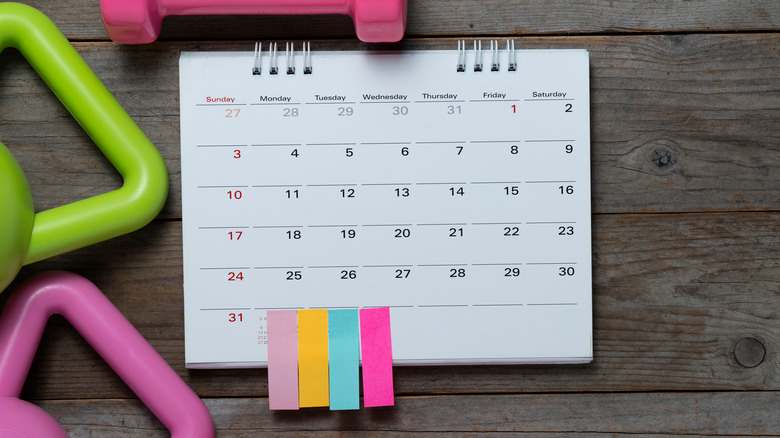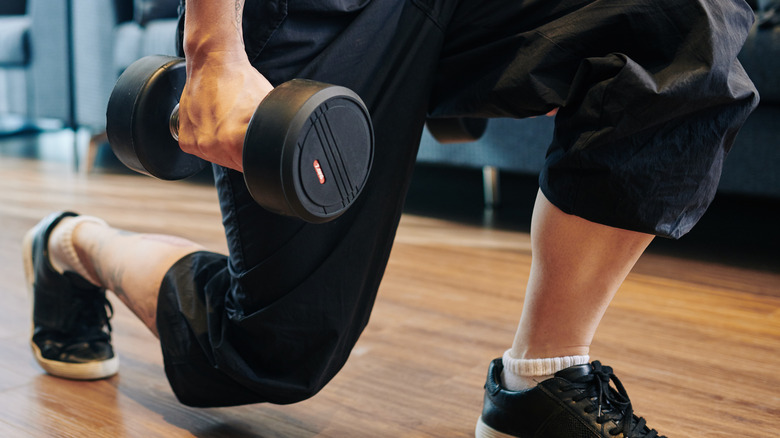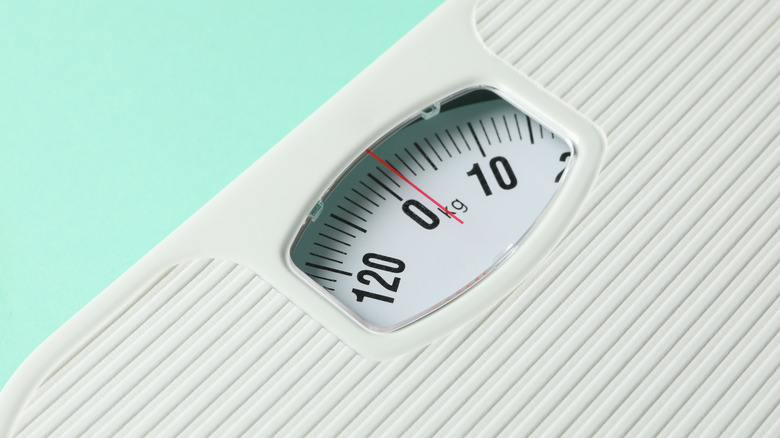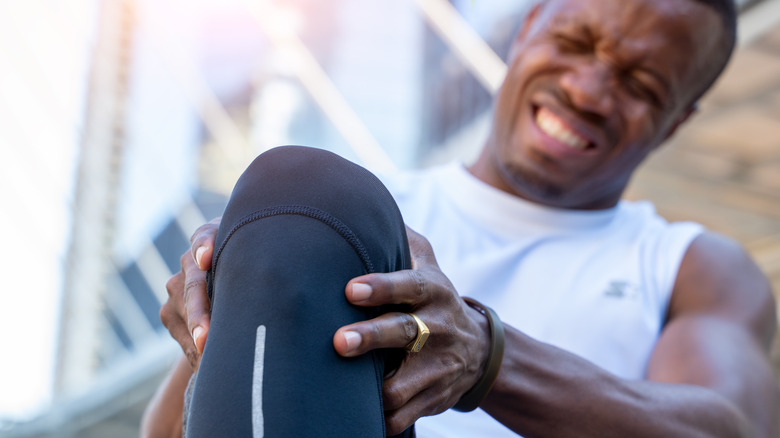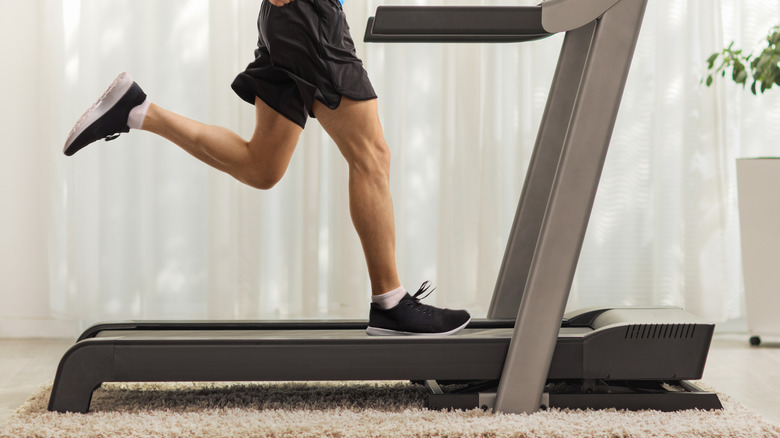Common Cardio Myths You Should Stop Believing
If you were to ask a group of people to give examples of cardio exercises, you'd probably get a number of different answers, ranging from walking on a treadmill to intense dancing in an aerobics class. Some might even insist that if you're not huffing and puffing and drenched with sweat after a workout, then it isn't really cardio (or at least not effective cardio). But here's the thing: There are quite a few common misconceptions about cardio, which can impact one's workout goals.
Cardio exercise, which is short for cardiovascular exercise, has three basic characteristics (per the University of Colorado Hospital). First, cardio exercises are rhythmic. And no, that doesn't mean that they have to be done to music: Rather, they are continuous movements instead of stopping and starting ones. Second, cardio works large muscles, like the ones in the legs. And finally, cardio exercises push your lungs and your heart, so typically, a person will experience a faster heartrate and breathe harder when doing cardio.
Although cardio has its health benefits, you should speak with a health care professional before you begin or change your current workout routine. Additionally, be careful about falling into the trap of believing myths about this form of exercise. Doing so could not only add obstacles to your exercise routine, but also affect your overall health.
Myth: A cardio workout has to be an hour long
It's common to think that if you can't do cardio for an hour, you shouldn't bother at all. After all, as WebMD notes, Zumba workouts, which are a type of cardio exercise, are typically hour-long classes. But as common as this belief is, it's not accurate.
According to the U.S. Department of Health and Human Services (HHS), it's recommended that adults do certain amounts of "aerobic physical activity" every week. This can be moderately intense, vigorously intense, or a combination of the two. But depending on factors like the intensity of the workout, the most the HHS recommends is five hours per week. This means that doing cardio seven days a week for an hour each day would fall well outside their recommended guidelines. Furthermore, Harvard explains that it's all right to break up a cardio routine into 10- to 15-minute chunks throughout the day, rather than trying to do all your cardio at once. So, if you're pressed for time, you have the flexibility to incorporate smaller cardio sessions into your schedule.
Okay, but what if your schedule is really packed, to the point where even shorter cardio workouts don't seem possible? Well, you can up the intensity of your workout, which would mean you could exercise for a shorter amount of time per week. However, you should always speak with a health care professional before you start increasing your exercise regimen's intensity.
Myth: Never do cardio and weights on the same day
If you were to ask several people about their workout regimen, chances are some would say they do their cardio and weights on different days. They might even insist that doing both types of exercise on the same day can stunt one's muscles (per Muscle & Fitness). However, there's research that doesn't support this idea.
Researchers have concluded that doing cardio and weights on the same day isn't bad for muscle growth. One paper published in The Journal of Applied Physiology involved eight sedentary middle-aged men. Another study, published in Medicine & Science in Sports & Exercise, involved nine men who are physically active. Additionally, Scientific American notes that a study in The Journal of Strength and Conditioning Research recommends spacing out aerobics and strength training done on the same day by six hours to get the best results. And Mike Lagomarsine, director of fitness at Boston University's Fitness and Recreation Center, recommends cardio as a good warm-up before a workout.
The bottom line is, there's evidence indicating that you don't necessarily have to separate your cardio and strength training (including with weights) for different days. And working with a trainer at the gym can help you figure out the best combination of exercises for your fitness goals, as well as the best way to work them into your schedule.
Myth: Always do your cardio before weights
Here's a case of a cardio myth being partially true. Yes, there are times when you might want to do cardio before weights. However, doing your cardio after weights can also be the right move for your personalized exercise plan. It all depends on your specific fitness goals.
As the American Council on Exercise explains, reasons a person might workout can include losing weight, building up their physical strength, and increasing their endurance. But here's the thing: Which of these goals you prioritize can make a difference when it comes to when you do cardio. For example, if you want to increase your endurance, then the order should be cardio and then weights. According to Women's Health, doing cardio first can help one warm up before hitting the weights. However, if weight loss and reducing body fat is the goal, then doing weights before cardio typically yields better results.
And then there's building strength, which has different recommendations, depending on whether or not you're targeting specific areas of the body (per American Council on Exercise). If you have specific days in your workout dedicated to improving your lower body's strength, then it should be cardio before weights. However, if you're focusing on your upper body strength, then it's your call if you want to do cardio first or last. Lastly, if you want to just increase your strength in general, then do weights first.
Myth: Doing cardio before breakfast blasts away body fat
If you're a morning person and/or find early morning is the best time in your schedule for exercising, then by all means, working out at that time is fine. But if you're choosing to do your cardio before breakfast to try to burn the maximum amount of body fat, you might want to rethink your plan.
Your metabolism isn't like a car. In other words, if you don't turn a car on, it doesn't burn fuel — in contrast, you don't need to turn on your metabolism. As Bodybuilding.com explains, it's always "on," making decisions about using carbs and fat to meet your energy needs. Yes, exercising can give it a boost, but if you work out on a treadmill before breakfast, it would take at least two hours of nonstop cardio for there to be any significant amounts of fat burned, compared to a shorter cardio session after eating breakfast.
In addition, EPOC (excess post-exercise oxygen consumption) plays a role in the fat burning that occurs because of exercise. In a nutshell, the more EPOC one has following a workout, the more calories they burn, and most of those calories are from fat. And typically, eating prior to a workout session leads to higher levels of EPOC. Finally, not having fuel will not only make your workout harder (especially if you're doing high-intensity cardio), but also could damage your muscles.
Myth: Cardio is an instant fix for overeating
Let's be honest: Everyone overeats from time to time. Maybe it's following a stressful day at work, or perhaps it happens because of the hectic rush of the holiday season. And barring a medical condition, an occasional overindulgence is probably not going to be a problem. However, the idea that doing a little more cardio can magically make it as if that overindulgence never happened is simply not true.
According to the Institute of Nutrition and Fitness Sciences, this cardio myth doesn't properly take into consideration just how much cardio would be needed to "erase" the amount of calories one consumes when they overeat. For example, let's say you decided to indulge yourself and eat a burger and fries at lunch. That could be 1,100 calories. In order to have a shot at burning off those extra calories, you'd need to do two hours cardio — and even then, you might only burn off 600 calories. That's because the intensity of your workout isn't the only factor here; your weight is, too.
In addition, a constant cycle of overeating and then overdoing it at the gym, in an exercise class, etc. isn't good for one's body or health. This approach can lead to one viewing overeating as something positive (a reward) and working out (in particular intense exercising) as a negative (a punishment). The bottom line is this cardio myth can be harmful, both to your physical and mental health.
Myth: If you want to lose weight, then only do cardio
Sometimes, a cardio myth has a little bit of truth in it. For instance, if someone wants to build up their muscular strength, then they should do strength training. From this fact, however, came the incorrect idea that such training always leads to bulky, heavy muscles, making it a bad choice for someone with weight loss goals. And this can lead to the flawed belief that doing cardio alone is the best way to lose weight.
As the Cleveland Clinic explains, both cardio and strength-training exercises can help one lose weight. In fact, the Clinic states that strength training can have a greater impact on weight loss. That's because in addition to building muscles, it can also really help rev up the metabolism, leading to more calories being burned in the course of a day. And in case you're wondering, while muscle mass can weigh more than fat, strength training exercises don't automatically make one's muscles bulky.
If you're feeling unsure about how to add strength training to your exercise routine, you might want to speak a fitness trainer (like the ones at your local gym) who can make recommendations based on your fitness goals. This might include specific strength training exercises, how much weight you should use, and the number of reps.
Myth: Cardio machine calorie counters are always 100% accurate
A convenient way to incorporate more cardio into an exercise routine is using devices at the gym like treadmills or ellipticals. Not only can these machines track how long you've been working out, they might also help you monitor the number of calories you burn during an exercise session. The important word here, however, is "might," since there's a catch when it comes to such calorie counters.
Stanford University & Karolinska Institute Exercise Physoiologist Dr. Mikael Mattsson cautioned Business Insider that exercise machine calorie monitors can be off by as much as 50%, perhaps even more. "The reason it's so difficult to get the calorie counts correct is that you're not really measuring the calorie counts," Dr. Mattsson explained. "So to do that, you need to measure all the cells in your body and how much energy they are using. And obviously, you're not going to do that." Instead, you're getting an approximate number of calories burned, which can be thrown off if (for instance) the machine isn't calibrated properly.
Where this can really turn into a problem is for someone who is using such machines as part of their workout regimen to lose weight. If that individual thinks the calorie counter is always basically accurate, then they might think they're burning more calories than they actually are, which could lead to them consuming more calories (and make it harder to reach their weight loss goals).
Myth: If you skip workouts (including cardio), your muscles become fat
Have you ever watched a cartoon where a character tries to flex a muscle, only for their upper arm to droop as if their muscles were nothing but flab? Obviously, this is just a visual gag to play the character's weakness for laughs. However, some people actually do think that if they start missing their regular exercise sessions, their muscles will transform into flabby fat.
If you've ever worried about this possibility, then there's good news. As Hahns Petty, an exercise physiologist at Piedmont Atlanta Fitness Center, explains, "Fat cells and muscle cells are different structures and are not interchangeable. It would be like an orange turning into an apple." So, even if you missed multiple cardio or weight-training workouts, it's physically impossible for your muscles to transform into fat.
But where did this misconception come from? When a person does skip doing their regular exercises, the cells of their muscles become smaller. And since that person is burning fewer calories, their fat cells increase in size. This can make their body seem softer and flabbier, creating the illusion that their muscles have turned into fat.
Fortunately, even during hectic times (like the holiday season), Petty has recommendations for keeping up with exercise, including cardio. For example, if getting to the gym and jumping on the treadmill isn't going to fit into your busy schedule, then walking around the mall while shopping can be a good substitute.
Myth: Cardio isn't effective if you're not sweating
Imagine this: You see two people at the gym who are both doing cardio exercises. One is sweating during their workout while the other doesn't appear to be sweating at all. Which person would you think was working out harder and would probably have better results from their exercise session? In all likelihood, you'd guess it's the person who is sweating. However, that's not necessarily true, since sweating has more to do with body temperature (per Women's Health).
Think about the last time you were outside on a particularly hot day. Chances are, you began sweating. This is because your body sensed that you were becoming overheated, and by sweating, your body tried to cool itself down. And while sweating and exercising typically go hand in hand, Dr. Abbie Smith-Ryan, associate professor of exercise physiology at the University of North Carolina Chapel Hill, explained that "sweating is not a direct indication of how many calories or how much fat you're burning."
Okay, but surely the more you sweat during a workout, the more intense it is, right? Not really. As Dr. Smith-Ryan states, "[sweat] is also not a direct indication of exercise intensity." In fact, there are other factors that can impact how much someone sweats while exercising (e.g., hydration, how old the person is, how much they weigh, their level of fitness).
Myth: Always push through the pain during a cardio workout
Because exercise involves pushing one's body, there's a widely held belief that it has to be painful. Some would even argue that if you're not experiencing pain, you're not performing the exercise correctly (or at least, not pushing yourself hard enough). And while there is a tiny kernel of truth in "no pain, no gain," pushing through every type of pain you might experiencing during a workout, cardio or otherwise, can be detrimental to your health.
As sports medicine physician Dr. Dominic King tells the Cleveland Clinic, it's natural to experience some discomfort because of exercise. This is in part because working out causes microtears that can occur in one's tendons or muscles. When the body repairs these tears, the muscles and tendons become stronger. However, Dr. King notes that the type of discomfort one should experience because of exercise is "soreness or achiness." Stronger pain can be an indication of an injury, and trying to push through it could make the situation worse.
Besides possibly warning you that you're straining your muscles and/or tendons, orthopedic surgeon Dr. Mark S. Schickendantz tells the Cleveland Clinic that pain while working out can be a red flag of a more serious injury, and that you should seek medical help in such instances. Some warning signs to watch for include sharp pain, large amounts of swelling, pain that is so severe you are unable to sleep, and difficulty moving part of your body.
Myth: The fat-burning zone is the key to losing weight
If you research cardio and weight loss online, you'll likely find articles recommending lower-intensity cardio over more intense cardio workouts if you want to really blast body fat. As Women's Health explains, this idea of keeping your heart rate at a certain level is referred to as the "fat-burning zone." There is a small amount of truth to this idea, but not enough to make this cardio myth true.
As health and fitness expert Chris Divecchio explains on his blog, both low-intensity and higher-intensity cardio workouts can help one burn calories, specifically calories from fat. In fact, the lower-intensity workout might lead to more calories from fat being burned. However, higher-intensity workouts tend to "burn more TOTAL calories as well as fat calories." Remember, calories can also come from carbs and protein (via Cleveland Clinic). In addition, Women's Health explains that while you will burn calories walking, you're more likely to burn more calories running.
While higher-intensity cardio exercises tend to help one lose more weight more quickly, if someone is just beginning working out regularly, it's all right for them to start with something lower in intensity. After all, as the old saying goes, "you have to walk before you can run." Less intense cardio workouts will still help blast body fat, as well as build up to more intense exercises.
Myth: If you're over 65, don't do moderately-intense cardio
This next myth is fueled by two generalizations: the idea that cardio is always a very intense workout (e.g., advanced versions of aerobic classes), and the notion that once someone reaches a certain age, they become weak, frail, and unable to handle any kind of vigorous exercise.
While there are intense forms of cardio, that doesn't mean there aren't lower-intensity cardiovascular exercises that older folks can safely perform. In addition, the Centers for Disease Control and Prevention (CDC) recommends that someone 65 years old or older should get either a minimum of 150 minutes of "moderately-intensity activity" or a minimum of 75 minutes of "vigorously-intensity activity" per a week. Some examples are common cardio exercises like brisk walking for moderately-intense activity and running, hiking, and jogging for vigorously-intense activities.
In addition, Forbes' recommendations for aerobic activities for those 65 or older include dancing, cycling, and swimming. Of course, everyone is different, so if you're 65 or older, you should speak with your health care professional before starting or changing a workout regimen. But with that said, don't let your age discourage you from exercising in general. The CDC recommends not only different types of cardio for adults above 65, but also weekly exercises to help with balance and muscle strength.
Myth: Stretching before cardio is always recommended
Typically, a person stretches before getting ready to work out, because they think that doing so will let them perform at their best and reduce their chances of injury. As Boston University (BU) notes, this was a very common belief. However, stretching before cardio might not only be unnecessary, but also unwise depending on the type of stretches done.
Research into this topic has found that stretching doesn't safeguard against injury, and may even impede performance. This includes cardio activities: Researchers found that stretching led to runners not running as fast. However, these findings don't necessarily mean all types of stretching are off the table. Glenn Harris, Boston University Athletics head strength and conditioning coach, recommends dynamic stretching as opposed to static stretching before exercise. According to the Hospital for Special Surgery, static stretching is holding a position for 45 seconds at most. Dynamic stretching, on the other hand, involves controlled movements like twisting at the torso or doing walking lunges.
And here's one final twist on this myth. Mike Lagomarsine, director of fitness at BU's Fitness and Recreation Center, states that since dynamic stretching increases one's heart rate and warms up one's body, cardio exercises can effectively serve as dynamic stretching before a workout. He even singles out certain cardio exercises like jump jacks and jumping rope, as well as types that involve machines like bikes, treadmills, and ellipticals.
Myth: You don't need leg day if you do certain cardio exercises
A common practice is to focus certain parts of a weekly workout routine on different parts of the body. Leg day, for example, focuses on the lower half of the body, specifically the muscles in the legs. According to Piedmont Healthcare, some exercises that might be part of a person's leg day include lunges and squats. Admittedly, these types of exercises can be difficult, so it's not surprising that someone might consider swapping such leg day exercises for cardio like jogging outdoors while listening to music. After all, both exercises work the legs, right?
Well, it's not that simple. Exercise scientist Dr. Wayne Westcott recalled to Women's Health that he used to coach track at The University of Pennsylvania. During his time there, he said that the runners he worked with "dominated the sport," citing their strength training as a key component of their success. "We were the only ones at the time having our athletes strength-train," he said, observing that "now, of course, everybody does."
In addition to possibly helping improve one's performance as a runner, not skipping leg day (or swapping it for a cardio workout) can also help with other fitness and health concerns like posture, muscle tone, and bone strength (per Healthline). And yes, strength training exercises that target the legs can also help with weight loss.

